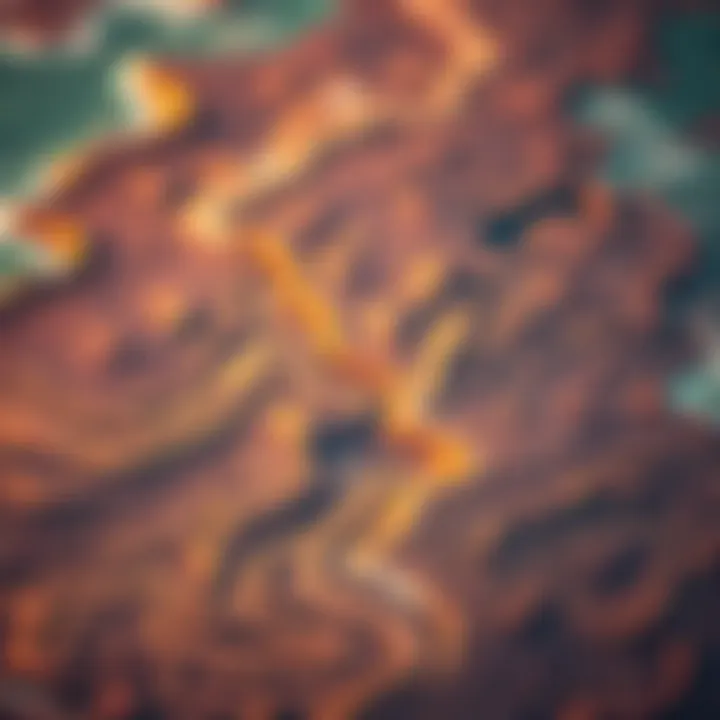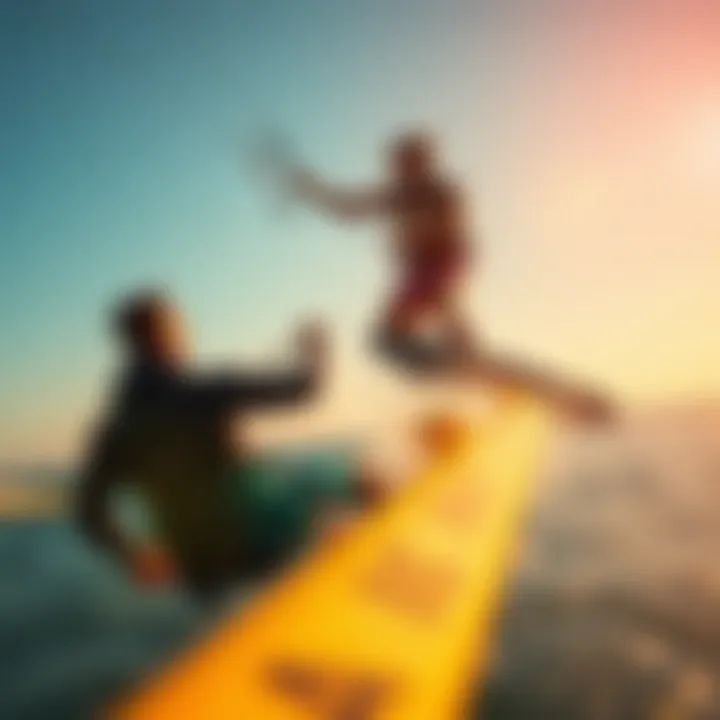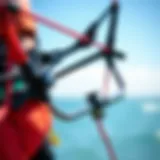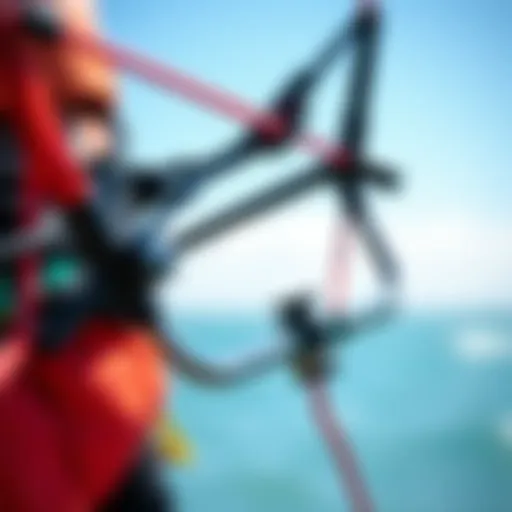Understanding Wind Maps for Kiteboarding in New Jersey


Intro
Kiteboarding in New Jersey is more than just a sport; it’s an exhilarating dance with the wind, a harmony that blends human skill with nature’s breath. Understanding the dynamics of wind maps is essential for both enthusiasts and experts alike who want to make the most of their rides. Wind maps can reveal subtle shifts and patterns that might otherwise go unnoticed, significantly influencing when and where to kiteboard.
This article takes a long, hard look at the specific wind conditions surrounding New Jersey and how they correlate with the best kiteboarding practices. It dives deep into methodologies for generating these wind maps. It explores how to accurately interpret them, and what kiteboarders need to keep in mind for better safety and enhanced performance. As we navigate through the winds of change, riders will discover not only how to ride the breeze but also to respect its power, turning every session into a controlled exploration of both skill and nature.
Gear Selection
The quest for the perfect riding experience starts with the right equipment. Kiteboarding gear can make or break a session, so understanding how different components interact with wind maps is crucial.
Types of Kites
Selecting the right kite can be a daunting task. Different kites serve various conditions and riders’ preferences. Here’s a look at the main types you might consider:
- C-Kites: Designed for freestyle and strong winds, they offer responsiveness but require more skill to handle effectively.
- Bow Kites: These are great for beginners and those wanting to increase lift. They perform well in light winds and can be depowered easily.
- Delta Kites: Known for versatility, delta kites work well in various wind conditions and are beginner-friendly.
- Foil Kites: Best for light wind days, these kites can get you up on the water when other kites might struggle.
Understanding wind maps helps riders choose kites tailored to specific locales and current conditions. The texture of wind—its strength and direction—can dictate if your kite will give you the ride of a lifetime or just a lukewarm session.
Choosing the Right Board
Pairing the right board with your kite is just as essential as selecting the kite itself. The two must work in tandem, especially given New Jersey’s fluctuating wind conditions. Options include:
- Directional Boards: Suitable for waves, directional boards provide primary control for downwind riding.
- Twin Tip Boards: Versatile for both riding directions. These boards are commonly favored for freestyle and jumping.
- Foil Boards: A wonderful choice for flat water days, they lift out the water and offer a unique ride that slaloms over waves instead of slicing through them.
When selecting a board, consider how it interacts with wind patterns on the maps. Riders should always anticipate and prepare for shifts in flow, ensuring their gear can adapt accordingly without sacrificing performance.
"Gear that works with the wind, not against it, is the key to unlocking unparalleled kiteboarding experiences."
In summary, gearing up for kiteboarding in New Jersey necessitates understanding wind dynamics represented in local wind maps. Aligning your kite and board choices with the prevalent wind conditions can lead to not just safer rides, but much more enjoyable ones as well.
Foreword to Wind Maps
Wind maps serve as essential tools for understanding how wind interacts with the geographic features of an area. For kiteboarding enthusiasts in New Jersey, these maps are particularly significant, offering insights into optimal conditions for riding and helping navigators make informed decisions. Understanding wind maps is not just an academic exercise; it directly translates to improved performance on the water, better safety practices, and more enjoyable experiences for all involved.
Defining Wind Maps and Their Importance
Wind maps are graphical representations that illustrate the patterns of wind direction, speed, and frequency over a specific region. They are typically colored and labeled to show variations at different altitudes and times of the year. For kiteboarders, having access to accurate wind maps means they can pinpoint the best spots for their activities, maximizing enjoyment while minimizing risks. These maps take into account multiple factors such as topography, climate, and historical data. Without them, riders might find themselves at the mercy of unpredictable conditions.
The need for precise wind data becomes clear when considering the diverse weather conditions that can sweep through New Jersey. From shore breaks in the summer to robust gusts in the fall, kiteboarders must be savvy in understanding how wind patterns change. By consulting wind maps, riders can boost their chances for an exhilarating kite session.
Historical Context of Wind Mapping
The practice of wind mapping isn't new; it has roots that trace back centuries. Early sailors relied on rudimentary maps to navigate and predict wind behavior, shaping their routes as they ventured across oceans. Fast forward to today, New Jersey's coastal communities benefit from both historical knowledge and modern technology, allowing for a more comprehensive understanding of local wind dynamics.
Advancements in technology have expanded the capabilities of wind mapping. With tools like satellite imagery and real-time data collection, today’s wind maps are becoming more refined and accurate. These developments have greatly enhanced the kiteboarding experience, providing a clearer picture of both seasonal trends and daily conditions. As kiteboarding gains popularity, recognizing the evolution of wind mapping becomes essential. It's not just about aesthetics; it’s about survival, performance, and connecting with the area’s unique environmental features.
"Understanding historical nuances in wind mapping culminates into a better kiteboarding experience today."
Wind Patterns in New Jersey
Understanding wind patterns in New Jersey is akin to reading the subtle signs of nature, vital for anyone who wishes to take to the water on a kiteboard. Wind isn't just air moving haphazardly; it interacts with the geographical aspect of the region, shaping both the environment and the experiences of kiteboarders. Having a grasp of these wind dynamics offers several benefits—optimal performance when riding, ensuring safety during sessions, and fostering greater connectivity with the local environment. This knowledge can make the difference between a mediocre outing and an exhilarating adventure.
Geographical Factors Influencing Wind
The very foundation of New Jersey's wind patterns lies within its unique geographical features. The state is blessed with diverse terrains, which play a pivotal role in determining how winds behave. The Atlantic coastline, with its extensive beaches, faces directly towards the ocean breezes, harnessing cool, refreshing gusts during the summer months. Conversely, areas inland, such as the Pine Barrens or the Appalachian foothills, can experience more unpredictable and turbulent winds.
Consider the role of topography in shaping these winds. The presence of hills and valleys can cause winds to funnel or even swirl unpredictably—think of them as natural wind tunnels. For kiteboarders, knowing which areas are likely to harbor steady winds in particular conditions is essential. For example, kiteboarding near Sandy Hook often means prevailing winds dictated by the coastal landscape, while areas like Cape May may present different scenarios depending on the local geography.
Furthermore, proximity to water bodies cannot be overlooked. The difference in temperature between land and water creates a breeze that often draws in wind patterns favorable for kiteboarding. As the sun heats up the ground, the resulting air currents move toward the cooler ocean waters, creating a thrilling experience for riders. In contrast, inland areas can sometimes catch the foreboding calm before a storm, leading to gusty conditions that might not suit less experienced kiteboarders.


Seasonal Variations and Their Impacts
Once the geographical aspects are taken into account, one cannot dismiss the impact of seasonal variations on wind patterns. New Jersey’s four distinct seasons bring with them a diverse range of wind conditions. Each season tells a unique story about what kiteboarders can expect.
- Spring often heralds the arrival of consistent breezes ideal for beginners. Warmer temperatures compared to winter lead to smoother winds as the air fills with moisture from the thawing ground. It’s an excellent time to gear up and hone your skills.
- Summer tends to offer the most predictable winds, as sea breezes typically emerge during the hotter parts of the day, providing kiteboarders with steady conditions. The challenge, however, lies in navigating around the heavy recreational boating traffic typical of this season.
- Autumn, a favorite among many seasoned riders, brings an upswing in wind consistency and strength. Cooler temperatures juxtaposed with the remaining warmth of summer create powerful gusts, adding an exciting edge to rides. However, these winds can also carry more unpredictable shifts, so vigilance is paramount.
- Winter often relegates kiteboarding to indoor strategies and preparations. The cold air can deliver harsh winds, which while exhilarating, demand expert handling. Choose your days carefully, as not everyone can embrace the chill!
Understanding the seasonal shifts and their resultant wind behaviors allows kiteboarders to time their sessions perfectly and prepare appropriately. Wind maps can also help in predicting these variations, helping enthusiasts to connect the dots between what they experience on the water and what is likely occurring in the atmosphere.
"The direction and strength of the wind can transform a kiteboarding session into a memorable escapade or a hasty retreat—knowing the patterns can mean the world."
In summary, by grasping the geographical influences and seasonal shifts, individuals can better harness the wind in New Jersey for kiteboarding, amplifying the thrill and minimizing risks in their practices. This understanding enriches the experience and supports responsible kiteboarding within the local community.
Creating Wind Maps
Creating wind maps is a crucial element in understanding the dynamics of wind patterns, especially for kiteboarding in New Jersey. These maps serve not just as a guide but as a powerful tool that enhances the experience for enthusiasts and professionals alike. The significance of wind maps transcends beyond mere navigation; they provide insights into local air movements, which are essential for optimizing kiteboarding performance and ensuring safety on the water.
Methodologies for Data Collection
Accurate data collection is the backbone of high-quality wind maps. To produce these maps, various methodologies are employed, each with its strengths and weaknesses.
- Anemometers and Weather Stations: Ground-based weather stations equipped with anemometers collect real-time wind speed and direction data. These stations, strategically placed across New Jersey, form the database for the wind maps. However, they can only provide localized data, which might not capture broader weather patterns.
- Satellite Imaging: This technology offers a bird's-eye view of wind movement across large areas. By analyzing satellite data and combining it with ground measurements, researchers can create more accurate and comprehensive wind maps. Despite being effective, satellite data can lag behind in real-time applications.
- Numerical Weather Prediction Models: These sophisticated computer models simulate atmospheric conditions based on various physical laws. They are used to predict wind patterns by integrating data from multiple sources, creating an expansive picture of the wind behavior throughout different geographical regions.
Each of these methods contributes uniquely to the final product, allowing for a compilation of wind data that reflects the diverse climatic characteristics of New Jersey.
Technological Advances in Mapping
The tools and technologies available for creating wind maps have come a long way.
- Remote Sensing: Advancements in remote sensing technology have allowed for more effective gathering of wind data across challenging terrains, like coastal areas or mountainous regions. This technology uses light- or radio-waves to identify and track wind patterns, providing information that ground-based sensors might miss.
- Mobile Apps: Modern kiteboarders can now access wind maps on their smartphones. Applications like Windy or Kite Dream utilize GPS and user-submitted data to provide real-time updates and forecasts tailored specifically for kiteboarding activities. This immediate access helps riders identify the best spots for their skill level.
- Collaboration Platforms: Online communities and platforms enable kiteboarders to share their experiences and local knowledge. Through forums or social media groups on Reddit and Facebook, riders can discuss conditions and tips, enhancing the collective understanding of wind behavior.
"Utilizing advanced technology and data collection methods not only improves the accuracy of wind maps but also fosters a supportive community for kiteboarders."
The interplay of technology and data collection methodology is reshaping how kiteboarders perceive and utilize wind maps. By integrating cutting-edge tools, riders can make informed decisions that positively impact their kiteboarding experiences and safety. As New Jersey continues to evolve as a prime location for the sport, the importance of reliable wind mapping cannot be overstated.
Interpreting Wind Maps
Understanding how to interpret wind maps effectively can significantly enhance the kiteboarding experience for riders in New Jersey. Wind maps are not just random data; they serve as a lifeline, giving insights into how wind behaves over different geographical features and conditions. For kiteboarders, the ability to read these maps can mean the difference between a thrilling ride and a stunted session that leaves one feeling frustrated.
Understanding Wind Speed and Direction
At the heart of any wind map are the elements of wind speed and direction. These two factors influence not only the feasibility of kiteboarding but also its enjoyment levels. In simple terms, wind speed is measured in knots and indicates how fast the wind is blowing at a particular area. For kiteboarding enthusiasts, knowing whether the wind is blowing at 10 knots versus 20 knots can drastically affect the type of gear they choose.
Wind direction, measured in degrees, tells kiteboarders from which direction the wind is coming. Generally, when looking at a wind map, one must consider the following:
- Crosswinds: Ideal for maneuvers but may carry the rider far from the launch point.
- Onshore winds: Provide a smooth ride but come with risks like getting pushed back toward shore.
- Offshore winds: Often create one of the more exhilarating experiences but pose a risk of drifting away from the safety of the shore.
The effectiveness with which a kiteboarder can maneuver on the water is directly tied to these elements. By understanding where and when the winds shift, riders can make informed choices about when and where to hit the water.
Utilizing Wind Maps for Kiteboarding
Once kiteboarders grasp how to read wind speed and direction, they can turn their attention toward utilizing this information. Wind maps serve as a strategic tool that can help maximize their experience. Here are several steps that enhance kiteboarding sessions using wind maps:
- Select the Right Location: Use wind maps to identify locations that are aligned with the current wind patterns. If a rider sees either an ideal offshore or strong onshore wind at a local beach, it may be time to pack up the gear.
- Gear Selection: Depending on the wind conditions outlined in the wind maps, choosing the right gear becomes straightforward. Lower wind speeds may necessitate a larger kite, while stronger winds could lead to opting for a smaller kite for more control.
- Time Your Sessions: Knowing the peak wind times can also be immensely helpful. Wind maps often indicate how winds will shift throughout the day. Plan to take advantage of gusty hours.
- Monitor Changes: Wind conditions can be transient. It's crucial to keep track of updated wind maps on the day of an outing. Events like thunderstorms or changing fronts can alter conditions quickly, impacting safety and performance.
Ultimately, interpreting wind maps gives kiteboarders an edge, enabling them to make strategic decisions. These insights can enhance both performance and safety while contributing to a more fulfilling kiteboarding experience.
Implications for Kiteboarding Performance
Understanding wind maps is crucial for kiteboarders seeking to enhance their performance on the water. The dynamics of wind can create an exhilarating experience or pose significant challenges depending on various factors, primarily the wind conditions. For any kiteboarder, knowledge of the prevailing wind patterns and the ability to interpret these maps is not just beneficial; it’s essential for getting the most out of each session.


Wind Conditions for Different Skill Levels
Wind conditions can differ widely, and recognizing how these variations affect various skill levels is key for ensuring both safety and enjoyment. Different levels of experience among kiteboarders—from beginners who are just learning the ropes to advanced riders looking to perfect their tricks—dictate the wind conditions that are most beneficial.
- Beginners:
For newcomers, gentle winds ranging from 8 to 15 knots are considered ideal. This range allows novice kiteboarders to develop control and confidence without being overwhelmed. Wind maps highlighting these calmer zones are vital for ensuring they hit the water on suitable days. Activities like basic maneuvers become easier in these conditions, leading to a smoother progress in skill development. - Intermediate Riders:
Intermediate kiteboarders thrive in wind speeds of 15 to 25 knots. This wind range opens up new possibilities—like jumping and carving—that are key for skill growth. Understanding the nuances in wind patterns on a wind map is essential for selecting locations where these conditions prevail consistently. Riders at this level should beware of sudden gusts, which can add complexity to their sessions. - Advanced Riders:
For those at an advanced level, wind maps highlighting areas with winds exceeding 25 knots can be most exciting. These breezy conditions allow for high-octane maneuvers and more sophisticated tricks. However, safety becomes paramount as stronger currents and unpredictable gusts can create challenging scenarios. Advanced kiteboarders should familiarize themselves with mapping tools that predict sudden changes, ensuring they remain aware of their environment.
Techniques for Optimizing Wind Use
In addition to understanding the conditions suitable for their skill level, kiteboarders can adopt specific techniques to make the most out of the wind available to them. Optimizing wind use can significantly enhance performance and extend the duration of sessions.
- Reading the Wind:
Kiteboarders should develop the skill of reading the wind. Observing how it interacts with the water surface can offer clues about stronger or gusty areas. Knowledge gained from wind maps complemented with real-time observations can refine this skill. - Adjusting Equipment:
The right kite size is paramount; using a kite too large for the given wind conditions can lead to a rough experience. Wind maps can inform choices regarding which kite suits the day's wind strengths best. As a general rule, a smaller kite can offer more control in higher winds. - Utilizing Wind Patterns:
Riders can strategically select their starting point based on, say, coastal features or obstacles that funnel or block wind. Understanding where wind tends to intensify or ease off gives an upper hand. This knowledge of local geography plays into how efficiently one can ride under varying conditions.
"A kiteboarder who ignores the wind has no chance of mastering the water."
Mastering the art of kiteboarding is about more than just skill; it's about working with the wind, not against it. Make your sessions safer and more enjoyable by staying attuned to the vast amount of data wind maps can provide. Paying close attention to how and where wind flows enables kiteboarders to surf the waves optimally, harnessing the full potential of every breeze that sweeps across the New Jersey shores.
Safety Considerations
When it comes to kiteboarding, safety is not just a checkbox you can tick; it's the backbone of every thrilling moment on the water. New Jersey, with its unique wind maps, offers a range of opportunities but also presents distinct dangers. Understanding these risks associated with wind patterns can mean the difference between a remarkable session and a precarious one.
Understanding Risks Associated with Wind Patterns
Wind patterns can change faster than you can say "cutback." Local topography, weather fluctuations, and high tides can all induce sudden shifts in wind speed and direction. For kiteboarders, this means one must consider not just the immediate conditions but how they might develop throughout the day.
Some key risks include:
- Gusts and Lulls: A sudden increase in wind speed can cause a kite to become overpowered, leading to loss of control. Conversely, a lull can reduce power suddenly, causing instability.
- Shifting Directions: Wind that shifts from onshore to offshore can drag inexperienced riders toward dangerous areas, like rocky beaches or boat traffic zones.
- Obstructions: Trees, buildings, or cliffs can create wind shadows that lead to unpredictable and erratic airflow. Understanding where these obstructions are located in relation to launching or landing zones is critical.
To mitigate these risks, kiteboarders should familiarize themselves with local wind patterns by consulting wind maps regularly. Knowing when to hit the water or when to stay on land can save both lives and gear.
Best Practices for Safety on the Water
Engaging in kiteboarding isn't only about catching air; it’s also about ensuring your well-being while riding the waves. By adopting discipline in your approach and adhering to best practices, you will not only preserve your safety but also enrich the kiteboarding community.
Here are some best practices to keep in mind:
- Pre-Flight Risk Assessment: Before hitting the water, assess wind conditions using reliable wind maps. Apps on smartphones can provide real-time wind speeds and forecasts.
- Wear Safety Gear: Equip yourself with a helmet, impact vest, and a quick release system for your harness. While it might feel cumbersome, it can prevent serious injuries.
- Buddy System: Always have a friend ride with you. If something goes south, having someone nearby can make all the difference in responding to emergencies swiftly.
- Know Your Limits: Every kiteboarder should have a personal threshold for wind speed and conditions. Don’t push beyond it; respect your skill level and conditions.
- Regularly Check Your Gear: Before each session, inspect your lines, straps, and kite for wear and tear. Faulty equipment can lead to mishaps at sea.
"Safety first is safety always." – Charles M. Hayes
Lastly, it’s well worth your time to study local regulations as they apply to kiteboarding. Some areas may have restrictions based on season or environmental factors, which can play a significant role in ensuring that not only you but also wildlife and local communities are protected during your kiteboarding adventures. Armed with knowledge, gear, and a community that prioritizes safety, you’re setting up for an experience that's both thrilling and secure.
Environmental Awareness in Kiteboarding
In the realm of kiteboarding, where the thrill of the wind meets the vastness of water, it's crucial to consider the environmental impact of this sport. Awareness of the ecological consequences helps ensure that kiteboarding remains sustainable for future generations. As kiteboarders, enthusiasts, and instructors, understanding these factors enables us to protect both our beloved sport and the natural habitats we enjoy.
Impact of Wind on Coastal Ecosystems
Wind is not just the fuel for our kites; it has a profound role in shaping coastal ecosystems. Areas where kiteboarding is popular often feature rich biodiversity, with various species relying on these coastal habitats. Changes in wind patterns can significantly alter sediment transport and water circulation, affecting the life cycles of marine plants and animals.
For instance, strong winds can erode shorelines, threatening habitats for birds and sea turtles, while also impacting the stability of dune systems. Additionally, consistent, strong winds can affect the health of coral reefs by altering water temperature and salinity, which are critical for marine life.
- Key considerations include:
- Monitoring local wind patterns to assess potential impacts on coastal environments.
- Participating in conservation programs aimed at protecting sensitive habitats near kiteboarding locations.
- Being aware of and following regulations that protect wildlife during nesting seasons.
"The ocean and the wind are intertwined in a delicate dance that requires our respect and care. Kiteboarding should not only be about the thrill but also about stewardship of the environments we cherish."
Promoting Sustainable Kiteboarding Practices


Sustainability is the name of the game in today's kiteboarding culture. As kiteboarders, we can adopt practices that minimize our environmental footprint while still enjoying our sport to its fullest. Here are some practical steps and considerations:
- Choosing Eco-Friendly Gear:
When selecting kites and boards, look for brands that emphasize sustainable materials and production processes. This not only reduces waste but supports companies committed to protecting our environment. - Responsible Launch and Landing Areas:
Be mindful of where you launch and land your kite. Avoid disrupting sensitive vegetation and wildlife. Launching from designated spots helps prevent inadvertent damage to coastal ecosystems. - Engaging in Local Cleanup Efforts:
Participate in or organize beach cleanups. Keeping our waterways and shores clean ensures that the natural beauty we enjoy remains untainted and supports local wildlife. - Educating Others:
Share knowledge about environmental awareness with fellow kiteboarders. Spread the word about the impact of our sport on local ecosystems and inspire others to take action.
Ultimately, incorporating environmental awareness into our kiteboarding practices reflects our appreciation for the world around us. Through conscientious choices and actions, we can ensure that kiteboarding remains a viable and enjoyable sport for years to come.
Case Studies: Successful Kiteboarding Locations
Understanding successful kiteboarding locations is critical for any enthusiast looking to elevate their experience on the water. New Jersey, with its extensive coastline and unique wind patterns, offers several prime spots for kiteboarding. This section unpacks the significance of these case studies, focusing on specific environments, the benefits they provide, and various considerations to take into account.
Analyzing Conditions at Popular Spots
In New Jersey, distinct kiteboarding hotspots like Cape May, Long Beach Island, and Sandy Hook catch the eye of many kiteboarders. These locations are not just defined by their scenic beauty but also the wind conditions that enable a great ride.
- Cape May: Known for its consistent breezy conditions, Cape May often attracts kiteboarders looking for reliable winds from spring to fall. The coastal line is characterized by a mixture of onshore and cross-shore winds, providing versatile riding conditions. Riders benefit from a broad beach area that offers ample space for taking off and landing, along with a supportive local community.
- Long Beach Island: The uniqueness of Long Beach Island lies in its seasonal wind patterns. During summer, the ocean breezes become predominant, great for beginners to intermediate kiteboarders. Thanks to the island’s layout which narrows the waterway, it serves as a wind tunnel—enhancing the wind experience, while also minimize obstacles.
- Sandy Hook: Boasting both flat water and wave conditions, Sandy Hook caters to diverse riding styles. The area experiences winds blowing predominantly from the southwest, which creates an exhilarating ride for more experienced riders. Its proximity to the Atlantic Ocean means faster air currents that can significantly affect performance.
These case studies demonstrate how environmental elements directly influence kiteboarding conditions, making it essential for riders to understand local weather patterns and geographical nuances.
Lessons Learned from Kiteboarding Communities
From these experiences, kiteboarding enthusiasts and communities can glean valuable insights that enhance the overall kiteboarding experience. Here are a few key lessons:
- Local Knowledge is Gold: Engaging with local kiteboarding communities can offer insights into the best times to ride, hidden spots, and safety considerations. Forums, Facebook groups, or dedicated websites like Reddit’s kiteboarding community provide platforms for sharing experiences and advice.
- Weather Monitoring: Riders must prioritize real-time weather monitoring. A solid understanding of how changing weather impacts wind patterns is fundamental. Websites like NOAA (noaa.gov) offer forecasts specifically tailored for kiteboarding, and utilizing local wind apps can improve decision-making.
- Sustainability Awareness: Kiteboarding communities are becoming increasingly aware of their environmental impact. By practicing eco-friendly techniques, they promote not only their sport but also preserve the beautiful locations they love.
In summary, by analyzing these successful kiteboarding locations and embracing the lessons learned from their communities, riders can significantly enhance their skills and experience on the water. Whether you're just starting out or a seasoned pro, New Jersey offers a wealth of opportunities to make the most of the wind.
Future Directions in Wind Mapping
Understanding the future of wind mapping holds profound importance, especially as kiteboarding continues to gain traction. The exhilaration of kiteboarding lies largely in harnessing the right winds, and a thorough grasp of how wind maps are evolving can significantly enhance the riding experience. The increasing integration of technology and data analytics plays a crucial role in shaping accurate portrayals of wind conditions. As kiteboarders seek out the best locations and timings for their activities, understanding the nuances of wind mapping will directly influence their safety and performance on the water.
Emerging Technologies and How They Will Shape Mapping
In recent years, advances in technology have transformed the landscape of wind mapping. Tools such as drones and satellite imaging now provide unprecedented insights into wind conditions across varying terrains. These technologies allow for the gathering of real-time data, which significantly contributes to the accuracy of wind maps.
- Drone Surveys: Drones equipped with advanced sensors can fly over kiteboarding areas to capture comprehensive data on wind patterns, which is often too complex to measure from ground-based stations alone.
- Satellite Data Integration: By utilizing satellite data, researchers can combine climatic trends with local conditions, offering kiteboarders a more reliable forecast of wind speeds and directions over time.
This will not just aid experienced riders in planning their sessions but will also assist instructors in designing tailored lessons based on accurate, localized wind assessments. For communities interested in kiteboarding, this could usher in a new era of accessibility, where players at every skill level can find optimal conditions with relative ease.
Potential for Improved Accuracy and Accessibility
As kiteboarding grows in popularity, the precise mapping of wind conditions becomes more critical. The growing reliance on big data analytics permits real-time adjustments and improvements in wind forecasts. Developers for kiteboarding apps are harnessing machine learning to enhance predictive capabilities, making wind maps not only more accurate but also more user-friendly.
The benefits of improved wind mapping are manifold:
- Increased Safety: Accurate wind information significantly reduces the risks of accidents associated with sudden gusts or shifts in wind direction.
- Greater Participation: With user-friendly apps and platforms, novice kiteboarders are better equipped to pursue the sport, broadening the community and filling local kiteboarding spots.
- Sustainability Initiatives: Effective mapping promotes environmentally responsible navigation of the sport, encouraging riders to respect local ecosystems while enjoying their pastime.
As wind maps evolve, they will offer a more dynamic and detailed perspective, promising a future where kiteboarding is safer, more accessible, and environmentally considerate.
"Always remember, the winds may guide your kite, but informed decisions steer your adventure."
Ensuring kiteboarders are equipped with precise wind mapping tools stands to fundamentally change individual experiences and the kiteboarding community at large. In this era of rapid technological advancements, it’s vital to embrace these developments and adjust strategies accordingly.
Closure
The conclusion of this article sheds light on the multifaceted importance of wind maps in kiteboarding, particularly within the vibrant backdrop of New Jersey. As kiteboarders harness the elements to complement their skill and enthusiasm, understanding the nuances of wind patterns becomes paramount. Through this exploration, we have dissected various components—from the geographical forces at play to the advancements in mapping technology—that shape our ability to make informed decisions on the water.
Recap of Key Insights
To encapsulate, wind maps serve as more than just pictorial representations of wind speeds and directions; they are essential tools that empower riders. Specifically:
- Strategic Planning: Kiteboarders can utilize wind maps to anticipate wind conditions at popular kiteboarding spots. Knowledge of seasonal variations can help in selecting ideal days for optimal performance.
- Identifying Safety Precautions: Previous sections highlighted how understanding wind patterns not only aids in performance but also ensures safety. Recognizing hazardous wind conditions can prevent accidents and foster a secure kiteboarding environment.
- Environmental Considerations: Emphasizing the relationship between wind and coastal ecosystems fosters an awareness that is crucial for sustainable kiteboarding practices.
- Community Insights: The insights gathered from successful kiteboarding locations underscore the importance of community knowledge in interpreting wind maps and experiences.
Encouragement for Thoughtful Kiteboarding Practices
As we wrap up this article, it is essential to urge kiteboarders, both seasoned and novice, to adopt a mindset that prioritizes responsible practices. Kiteboarding can be incredibly fulfilling, but it also comes with risks associated with changing wind conditions. Here are a few pointers to keep in mind as you take to the water:
- Stay Informed: Regularly check wind forecasts and updates from trusted wind map sources. Being aware of how conditions are evolving on any given day can prepare you to adjust your plans accordingly.
- Practice Respectfully: Always be considerate of the environment and other water users. It is vital to minimize your impact on coastal ecosystems, sharing the water space while ensuring safety to all involved.
- Learn from the Community: Connect with local kiteboarding groups and share experiences. Observing how others utilize wind maps can provide new perspectives and techniques that enhance your skill and enjoyment.
- Invest in Continuous Learning: Consider taking lessons or workshops that focus on wind dynamics and safety measures. Knowledge gained from these experiences can significantly improve your kiteboarding journey.















